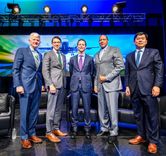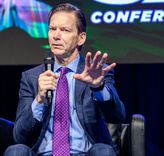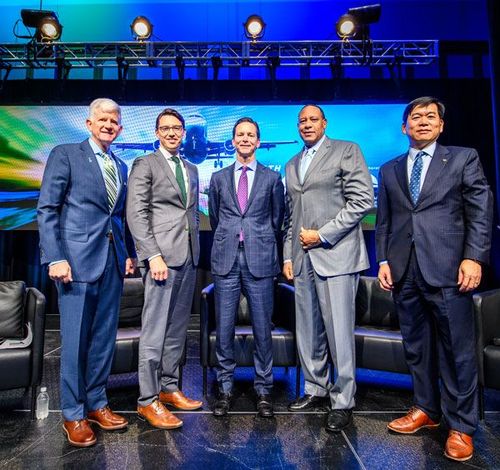Minnesota: SAF Central





Chris Tindal, CAAFI; Peter Frosch, Greater MSP; Peter Carter, Delta Air Lines; Brett Carter, Xcel Energy; Sam Tsu, Ecolab. / PHOTO: JOE SZURSZEWSKI
Invalid Date
BY Anna Simet
The inaugural North American SAF Conference & Expo, held in Minneapolis at the end of August, was a fitting location for the unveiling of plans to build out the U.S.’s first SAF hub, a multiyear, ambitious strategy to which its partners reiterated their long-term commitments.
Prior to the announcement, ChrisTindal, assistant director and business team lead at the Commercial Aviation Alternative Fuels Institute, provided a snapshot of what the domestic and global SAF industries look like and whether current production trajectories shore up goals. “So far this year, we [the U.S.] have consumed about 12.8 million gallons of SAF,” Tindal said. “Total [annual] jet fuel use in the U.S. is 26 billion gallons. While we’re on track to exceed 22 million by the end of this year, which is the greatest year we’ve ever had, it’s only 0.1% of total jet fuel consumed in the U.S.”
Tindal said while that number is very small, it’s not a doom-and-gloom scenario. “By 2030, we want to have 3 billion gallons being produced domestically, which would be about 20% of total jet fuel consumption in the U.S. And by 2050, we want to replace all fossil jet with SAF. That is feasible, we can certainly do it—but how?”
Advertisement
Tindal said activities like the SAF Grand Challenge, SAF Tax Credit and the forthcoming Minnesota SAF Hub will help stimulate growth needed to hit milestones. Following his remarks, he welcomed panelists to the stage, including Peter Frosch, president and CEO of the Greater MSP Partnership; Peter Carter, executive vice president of external affairs at Delta Air Lines; Brett Carter, executive vice president at Xcel Energy; and Sam Hsu, executive vice president of strategic planning at Ecolab.
Frosch said the MN SAF Hub has been in the works for many months. “Now we’re at the point of where it’s time to tell the story about the work we’re going to do together here,” he said. “This set of anchor companies and key parties have come together to address the issue, which is that there must be a set of places around the world that are achieving SAF production at scale, where large volumes of affordable, low-carbon SAF are consistently produced. We’ve come to together to build …an integrated value chain that will result in delivering hundreds of millions of gallons of SAF to the [Minneapolis-Saint Paul International Airport] for use, and we’re committed to doing the things and solving the problems to get there.”
Carter said partnering for the SAF hub aligned with Delta’s commitment, made in February 2022, to be a net zero airline by 2050. The goal includes a stepping stone of using upward of 10% SAF for fuel at MSP by 2027, and 50% by 2035. “Putting this all into context, at Delta, we consume four billion gallons of jet fuel every year, with 250 million gallons consumed out of MSP. For us, 98% of our carbon footprint is generated by jet fuel. So, we need jet fuel to be replaced by SAF as scale. And right now, as you all know, there isn’t enough in the whole world to even fuel Delta for a single day.”
Catalyzing industry growth is more than a promise to buy fuel, from Carter’s perspective. “Candidly, we’ve done what we thought would generate and scale the industry by signing offtake agreements with the Gevos of the world, but that hasn’t been enough to drive the capital and spur development of a truly scalable industry,” he said. “So, that’s where we came to this thought that we need to be a part of something—a coalition of the willing, including the whole value chain—to bring people together to solve a difficult issue.”
Advertisement
Carter said that if a pin were to be dropped on any community in the world for a SAF hub, that Minnesota jumped out at Delta as the best host community, one reason being that current Gov. Tim Walz is a “huge champion of SAF,” as well as legislation passed earlier in the year that “positions Minnesota to be not just a national leader in scaling SAF, but a world leader,” he said. “The companies in the state of Minnesota, as represented by Xcel, Ecolab and Bank of America, these are companies that are global, that take on difficult issues and also companies that know how to collaborate.”
Carter also highlighted Minnesota’s agricultural community, which he described as “a crucial element to create SAF. You also have clean energy producers like Xcel, you have existing biofuel infrastructure, you have the right public policy as demonstrated by the state’s passing of the [Sustainable Aviation Fuel Tax Credit] SAF incentive law. You have a wonderful university system through the University of Minnesota where we expect additional research to be done, as we’ll need some technological breakthroughs to scale this industry. All of those things together make Minnesota really the place, not just in the country, but the world.”
As for the Minnesota SAF hub target of 250 MMgy per year by 2030, Tindal pointed out its significance. “We want 3 billion gallons [for the SAF Grand Challenge], and 250 million gallons is 8% of that total amount,” he added. “Just from Minnesota, 8%—that’s pretty phenomenal.”
Contact: Anna Simet
asimet@bbiinternational.com
Upcoming Events





